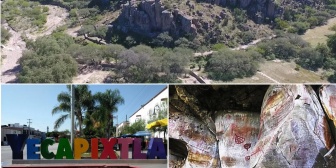Three places to see cave paintings in Mexico
News Category: News and General Discussion
-
Cave paintings are mostly evidence of the first type of human art that existed. The drawings were painted in caves or rocks and most date from prehistoric times, that is, when humans did not yet write.
This type of primitive art sought to represent the activities that were done in those times, for example, they used to depict the hunting of some animals, other activities, and surrounding elements such as trees.
In spite of the weather events and other factors, since they are found in places protected from erosion, they have been able to be maintained and cave paintings have been found all over the world.
In Mexico, there are many sites with cave paintings throughout the country. One of the closest sites to Mexico City is located in the state of Morelos, approximately two hours away by car.
Cave paintings in Yecapixtla, Morelos (Photo: CUARTOSCURO)
Not everything is jerky in Yecapixtla, since within the town of Achichipico there is a site with prominent rocks at the foot of a ravine and right there is where the pre-Hispanic vestiges of cave paintings are found.The drawings are several figures that show warriors in a kind of ceremony, so the site has an important historical and patrimonial value.
The trace of cave paintings in Chichiminquiahua is located at the bottom of Cerro Peña Alta, near Barranca Grande. There would be several drawings in white ink based on carbonates, others in black and appear red.
This site is located in Guanajuato, right between the capital and San Miguel de Allende. According to the media library of the National Institute of Anthropology and History (INAH), this site is one of the most representative of rock art.
Arroyo Seco is located southeast of the municipal capital Victoria and right in the center of a small valley, near a dry riverbed, there are rocks with rock art.
There are about 46 paintings on these rocks distributed in different places in the area. The reason for this is due to the cosmovision, ritual, and identity of the indigenous cultures.
These became known in the XVI century since the religious Guillermo de Santa Maria made reference to a place he called “the painted caves” and from what he described, it was in the same place.
Cañada el Marrón is one of the most important sites of manifestations related to rock art and especially with the presence of the bighorn sheep, now extinct in Nuevo León.
This site is located in the municipality of Mina, Nuevo Leon, where you can appreciate rock art in its maximum splendor.
To get there you must take a long excursion that begins in Puerto del Indio. Cañada El Marrón is very close to other archaeological sites such as Presa de la Mula, El Delgado and El Coyote.
It was named after the Sierra del Marrón, which has red colors in the stones, and also because of the brown cave paintings.


Leave a Reply